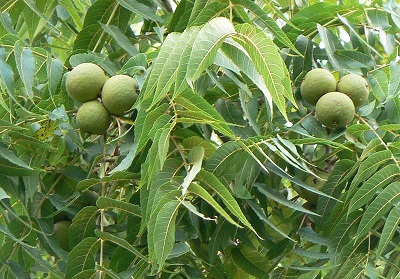A few years ago, I got into using natural dyes for some craft projects. I was experimenting with different plants and flowers, and read that walnut has a nice color. Since I have a nice supply of walnut trees in my yard, I grabbed a few nuts and went to work peeling them and using the husks on some scarves. At the time, my mother was wondering why we weren’t saving the nut meat too. Several weeks later, when my hands were STILL dyed brown from the husks, I was also curious why I didn’t stick to just the nuts.
As I mentioned, I have quite a few trees in my yard, so eventually I looked into how one processes the nuts (and got away from the dying). Before I get to that, I’m going to take us on a little sidetrack. Let’s talk about walnut biology first. I am located in the center of the state, and technically we are north of the good walnut (Juglans nigra) habitat. Stories, of the unbelievable prices walnut trees bring on the market, have made it up here, and have lured people in to planting them. Unfortunately, I’ve seen some pretty sad walnut plantations up here. As one of my college professors used to say, “You can grow bananas in Wisconsin too, but the resources you have to invest, and what you’ll get in return will quickly change your mind”. That is to say walnut can grow outside of their range, but you’ll want to readjust your expectations of the tree. So, let’s look at harvesting those nuts instead.

Black walnuts are a bit different from the walnuts we buy in the store, which are English walnuts. Once you process the black walnuts, you should do a little taste test. I’m sure the work you put into the black walnuts will automatically make them taste better. To start on this adventure, you’ll want to harvest the nuts when they ripen. You can tell if they are ripe when you press your thumb into the side of the husk and they leave an indentation. They are easiest to collect from the ground, if you can beat the squirrels to the harvest.
Once you have gathered your walnuts, it’s time to remove the husk. When the nuts are ripe, they will fall to the ground, but likely still be green. You can throw them in a bag for a couple of days or weeks (out of the sun) until the husk just starts to turn dark brown or black. Note, you do NOT want to store the nuts long-term this way as it will ruin the flavor of the nut meat, this first step is just meant to soften the husk so it is easier to remove. This is where it can get ugly. I can’t stress enough that you’ll want gloves. Peel the husk away from the shell, with your gloved hands, of course. I have heard of people who use a small cement mixer with a combo of water and small gravel, but I can’t speak to this method myself. In the end, you’ll want to dump the now bare nut shells all in a bucket with water to remove the last remaining bits of fiber from the shells.
The next step is to let the nuts dry for a while; you can hang them in mesh bags or cheese cloth for about 2-3 weeks. Once they’ve had that time to cure, you can do a quick test to see whether the nut meat inside is still good by floating them in water. Throw the floaters away as the meat is underdeveloped or dry. You’ll thank me for this later, as walnuts are quite difficult to crack, and going through the effort for a bad nut might end this little experiment for you. Don’t pull out Grandma’s antique nut cracker for this next part. You’ll want a good sturdy hammer and the sidewalk. Stand the nut on its end, and work out all your stress. Once you’ve cracked them, remove the meat from the shell; I’ve heard one person who uses wire cutters to finesse the nut meat out. Once they are shelled you can store the nuts in the refrigerator or the freezer for later use. At this point, you may wonder whether I should have stuck with the simplicity of dying with walnuts, but when you love food like I do, it’s worth it.
